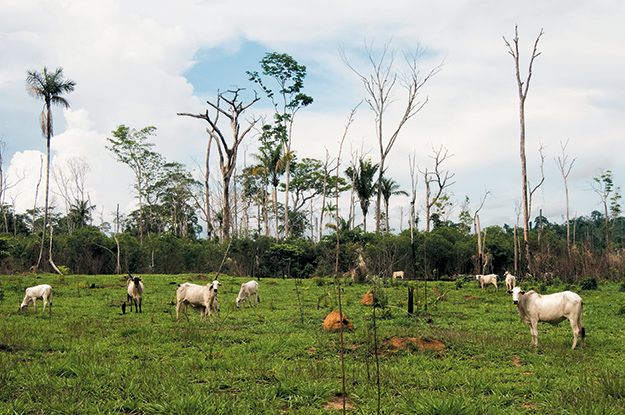This article is adapted from the Fall 2015 print edition of Americas Quarterly. To subscribe, please click here
A milestone has been reached in the fight against deforestation in the Amazon. Over the last five years, Brazil has seen the lowest deforestation rates since measurements began in 1988 — capping more than 10 years of effective action to reduce the rate of forest destruction. This is the result of coordinated and persistent efforts by government and civil society, and it is largely responsible for Brazil reducing its greenhouse gas emissions by about 41 percent since 2005. No other country in the world can boast such results. Currently, clear-cutting of large swaths of forest (over 1,000 hectares; 2,471 acres) is no longer the norm and has been replaced by smaller-scale and more gradual deforestation.
This change in behavior in the field, however, has required a new attitude by Brazilian authorities. They have begun implementing a number of new high-tech tools to increase the ability to detect deforestation. These include higher spatial and temporal resolution satellite images, the use of radar images to identify changes when weather limits visibility, and new systems to identify categories of land use and forest degradation and to detect areas burned.
Command and control instruments will not solve all of the Amazon’s daunting deforestation challenges. Therefore, in addition to monitoring land use, the Brazilian government’s efforts to tackle deforestation are also centered on promoting improved land-use planning for sustainable production.
The New Forestry Code, for example, with its powerful Rural Environmental Registry, will make it possible to differentiate illegal logging activities from legal efforts to suppress native vegetation, allowing for more focused and flexible inspection. It will even enable authorities to place restrictions on agricultural loans to landowners who do not comply with the new legislation.
More than 57 percent of properties subject to the law are already on the national database as of August 2015. When the database is completed in May 2016, it will provide a snapshot of the environmental assets of each rural property in the country. And the states that make up the Brazilian Amazon are leading the way, having registered 77 percent of their area.
Even as the government moves to protect vegetation in private lands, it is important to note that about 45 percent of the Brazilian Amazon is protected, either as indigenous lands or conservation units. Since it was launched in 2004, the Action Plan for the Prevention and Control of Legal Amazon Deforestation has helped set aside more than 50 million hectares in federal and state conservation units — protected areas on public lands that the Brazilian government has identified to conserve.
Recent efforts have focused on consolidating and maintaining existing conservation units and indigenous lands. Examples include: (1) the Amazon Region Protected Areas program, which invested $125 million toward the consolidation and management of over 58 million hectares (143 million acres) in 105 conservation units; (2) The Green Grants program, which offers conditional cash transfers to 73,000 families living in extreme poverty in protected areas and other priority areas, helping conserve natural resources; and (3) National Land Management and Environmental Policy for Indigenous Lands, which supports the integrated management of indigenous territories and their natural resources.
The program’s 2015 budget of 70 million reais ($19.7 million, at August 2015 exchange rates) will reach 40 indigenous lands, 73 ethnic groups and 905 villages. The resolution of land ownership issues in the Amazon is essential to reducing the pressure to open up new areas of rainforest. In 2013, a technical board was established to determine the best allocation and management of 55 million hectares (136 million acres) of federal public lands, of which 39 million hectares (96 million acres) are rain forest and therefore more susceptible to land-grabbing and illegal deforestation.
In less than two years, the technical board has already allocated about 36 million hectares, or 66 percent of the total land area within its responsibility. This work contributes to the regularization of private property, and the legal settlement of conservation units and indigenous lands. It also facilitates infrastructure planning by the federal government and the states. Of this total, about 6 million hectares are to be transferred to the federal government, creating protected areas and forest concessions for sustainable management activities.
Private-sector efforts have also been instrumental in changing the logic of land use in the Amazon. For example, the Soy Moratorium, signed in 2006 and extended through May 2016, commits the soy industry not to acquire any soy produced in deforested areas after July 2006. The latest annual monitoring reports show that soy was responsible for 4.6 percent of the deforestation in 73 producing municipalities and 1.6 percent of the deforested area of the Amazon biome in the 2013/2014 harvest.
Brazil’s achievements in reducing emissions caused by Amazon deforestation have qualified the country to receive international resources through the Amazon Fund. The Fund — internationally recognized as the largest REDD+ mechanism in the world — supports 74 projects totaling 1.15 billion reais, as of August 2015.
In addition to large infrastructure projects, approximately 330 million reais from the Amazon Fund were allocated to nonprofits, comprising over 1,200 small to medium subprojects aimed at strengthening community, extractive and family organizations. In this manner, Brazil is improving the performance of its national initiatives and is paving the way for cooperation with other Amazon countries.
The actions proposed by the Brazilian government for this region reflect a vision of economic development as well, where production and environmental protection coexist in an integrated fashion. Of course there are still several normative, regulatory and structural hurdles to be faced.
Still, a successful next stage in the management of the Amazon region depends on the consolidation of a strong forest-based economy — an economy where production is legal, accountable and transparent with broad access to national and international markets, while acknowledging the efforts of the people and institutions of this region in promoting increasingly sustainable use of the forest.




